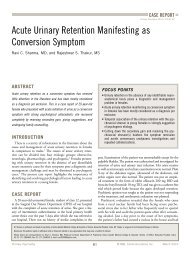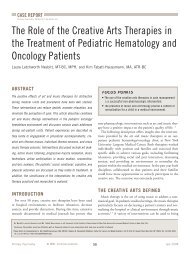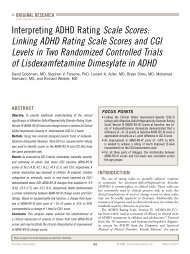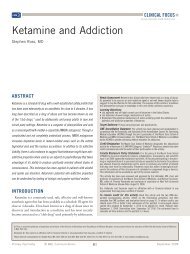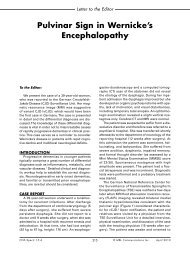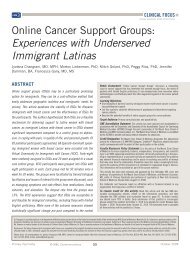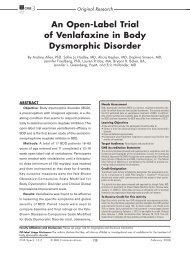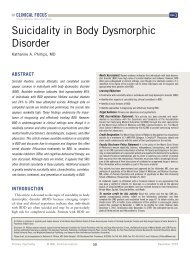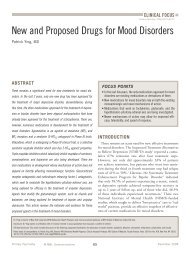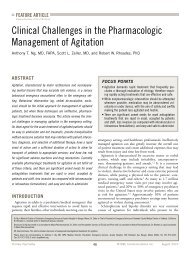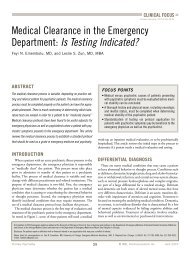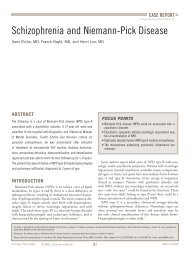Duloxetine For The Treatment Of Generalized Social Anxiety - MBL ...
Duloxetine For The Treatment Of Generalized Social Anxiety - MBL ...
Duloxetine For The Treatment Of Generalized Social Anxiety - MBL ...
You also want an ePaper? Increase the reach of your titles
YUMPU automatically turns print PDFs into web optimized ePapers that Google loves.
Original Research<br />
<strong>Duloxetine</strong> for the <strong>Treatment</strong> of<br />
<strong>Generalized</strong> <strong>Social</strong> <strong>Anxiety</strong> Disorder:<br />
A Preliminary Randomized Trial of<br />
Increased Dose to Optimize Response<br />
Naomi M. Simon, MD, MSc, John J. Worthington, MD, Samantha J. Moshier, BA,<br />
Elizabeth H. Marks, BA, Elizabeth A. Hoge, MD, Mina Brandes, MD,<br />
Hannah Delong, BA, and Mark H. Pollack, MD<br />
ABSTRACT<br />
Objective: This is the first trial examining<br />
duloxetine for generalized social anxiety disor-<br />
der (GSAD) and the effect of increased dose for<br />
those without early remission.<br />
Methods: Individuals (n=39) with GSAD<br />
received 6 weeks of open-label duloxetine 60<br />
mg/day; those with a Liebowitz <strong>Social</strong> <strong>Anxiety</strong><br />
Disorder Scale (LSAS) score >30 at week 6 were<br />
randomized in double-blind fashion to an addi-<br />
tional 18 weeks of continued duloxetine 60 mg/<br />
day or to duloxetine 120 mg/day.<br />
Results: <strong>Duloxetine</strong> was associated with<br />
a significant LSAS reduction at week 6 (91.3<br />
[17.7] to 69.8 [28.5], paired t [df]=5.2 [38],<br />
P
ciated with a moderate effect size (Cohen’s<br />
d=.57), there was no significant difference at<br />
week 24 endpoint in LSAS reduction (20.5 [26.0]<br />
versus 7.3 [17.2], t [df]=1.6 [26], P=.13) nor remis-<br />
sion (33% versus 8%) for duloxetine with dose<br />
increased to 120 mg/day compared to duloxetine<br />
continued at 60 mg/day. Overall, 44% (17/39) dis-<br />
continued prior to week 24.<br />
Conclusions: Though with limited power,<br />
these data provide preliminary support for the<br />
efficacy of duloxetine for GSAD, and suggest<br />
continued improvement but limited remission<br />
overall at 24 weeks for individuals remaining<br />
symptomatic at week 6. <strong>The</strong>se observations war-<br />
rant further controlled study.<br />
CNS Spectr. 2010;15(7):436-443.<br />
BACKGROUND<br />
<strong>Social</strong> anxiety disorder is common with a lifetime<br />
prevalence of 12.1%. 1 An expanding body<br />
of clinical experience and controlled trials has<br />
demonstrated the efficacy of selective serotonin<br />
reuptake inhibitors (SSRIs) and the serotonin<br />
norepinephrine reuptake inhibitor (SNRI) venlafaxine<br />
for the treatment of generalized social<br />
anxiety disorder (GSAD). Paroxetine, sertraline,<br />
and venlafaxine extended-release (XR) are<br />
Food and Drug Administration approved for this<br />
indication; nonetheless, many treated patients<br />
do not achieve a robust response, 2-6 suggesting<br />
additional pharmacotherapy strategies are<br />
needed. Most studies examining the acute efficacy<br />
of pharmacotherapy for GSAD, including<br />
the SSRIs, have reported that approximately<br />
one third to one half of patients do not meet<br />
responder criteria, with an even lower proportion<br />
achieving remission. 2,3,6<br />
<strong>The</strong> newest SNRI, duloxetine, has been<br />
shown to be effective at doses of 60 mg/day to<br />
120 mg/day for anxiety associated with depression,<br />
7 with possible greater efficacy for anxious<br />
compared to non-anxious depression. 8 Three<br />
large randomized controlled trials support the<br />
efficacy and FDA approval of duloxetine for generalized<br />
anxiety disorder (GAD). 9 While two case<br />
reports provide initial suggestive evidence, 10,11<br />
Original Research<br />
there are, to our knowledge, no published data<br />
systematically examining duloxetine for GSAD,<br />
or the effect of increased dose for those who do<br />
not remit with initial dosing.<br />
Clinicians regularly face the question of when<br />
to alter medication course for patients with<br />
GSAD, yet there are no empirically derived data<br />
available to guide practice. Although it often<br />
takes a number of months for patients with<br />
anxiety disorders to fully respond to pharmacotherapy,<br />
clinicians frequently raise the dose of<br />
medication early in the course of treatment. 12 It<br />
remains unclear, however, whether such dose<br />
escalation is warranted. Unnecessary dose elevations<br />
may result in greater side-effect burden<br />
and false expectations of truncated time<br />
to response, resulting in premature medication<br />
discontinuation for some patients. Because dose<br />
response data from fixed dose studies are not<br />
“stepped,” but random assignment, these and<br />
flexible dose studies do not address the impact<br />
of increasing dose for patients who remain<br />
symptomatic at initial dose levels, compared to<br />
those who continue at the same dose level. We<br />
are not aware of studies to date in GSAD that<br />
have addressed the relative benefit of increasing<br />
dose versus “watchful waiting” in patients with<br />
incomplete response to initial treatment.<br />
To address the paucity of data specifically<br />
regarding duloxetine for SAD, as well as the<br />
impact of antidepressant dose escalation for<br />
incomplete initial response, we initiated openlabel<br />
duloxetine at 60 mg/day for 6 weeks, and<br />
then randomized in double–blind fashion individuals<br />
who had not achieved remission at week<br />
6 to an additional 18 weeks of treatment with<br />
either duloxetine at an increased dose of 120<br />
mg/day or to duloxetine continued at 60 mg/<br />
day with the addition of placebo. We selected 6<br />
weeks as a time that a clinician in practice might<br />
reasonably choose to increase an antidepressant<br />
dose for a patient with GSAD who remained<br />
symptomatic. We hypothesized that duloxetine<br />
would be associated with a significant reduction<br />
in GSAD symptoms overall. Further, we<br />
hypothesized that those with persistent symptoms<br />
after 6 weeks of duloxetine at 60 mg/day<br />
would achieve greater response at week 24 endpoint<br />
after 18 additional weeks of duloxetine at<br />
an increased dose (to 120 mg/day) compared to<br />
those randomized to continue on the same 60<br />
mg/day (plus placebo) dose.<br />
CNS Spectr 15:7 437<br />
© <strong>MBL</strong> Communications Inc. July 2010
METHODS<br />
Subjects<br />
<strong>Treatment</strong>-seeking outpatients >18 years of<br />
age with a primary diagnosis of GSAD were<br />
recruited by media advertisement. All study<br />
procedures were approved by the Institutional<br />
Review Board at Massachusetts General Hospital<br />
(MGH), and all study participants signed written<br />
informed consent with a physician investigator<br />
prior to participation. Psychiatric screening<br />
was completed by study physicians, utilizing the<br />
Structured Clinical Interview for the Diagnostic<br />
and Statistical Manual of Mental Disorders,<br />
Fourth Edition. 13 Medical screening included<br />
medical history, physical exam, and laboratory<br />
testing, including complete blood count, chemistry<br />
screen, thyroid screening, urine toxicology,<br />
and pregnancy tests (for women).<br />
Eligible were adults >18 years of age with a primary<br />
current diagnosis of GSAD and a Liebowitz<br />
<strong>Social</strong> <strong>Anxiety</strong> Scale (LSAS) score >50. Exclusion<br />
criteria included concurrent use of other psychotropic<br />
medications (with β-blockers and anticonvulsants<br />
allowed if being used for a medical<br />
indication and if at a stable dose for >1 month);<br />
prior lack of response or intolerance of duloxetine;<br />
non-response to more than two prior pharmacotherapy<br />
trials at minimally adequate dose<br />
and duration; significant suicidal ideation (defined<br />
as a Montgomery Asberg Depression Rating Scale<br />
[MADRS] item 10 score >3), or suicidal behaviors<br />
within 6 months prior to intake. Diagnosis of any<br />
of the following DSM-IV mental disorders was<br />
exclusionary: a lifetime history of schizophrenia or<br />
any other psychosis, mental retardation, organic<br />
medical disorders or bipolar disorder; eating disorders<br />
in the past 6 months; alcohol or substance<br />
abuse in the past 3 months; or alcohol/substance<br />
dependence within the past 6 months. Entry of<br />
patients with major depressive disorder (MDD),<br />
dysthymia, panic disorder, GAD, posttraumatic<br />
stress disorder, or obsessive-compulsive disorder<br />
was permitted if GSAD was judged to be the predominant<br />
disorder, in order to increase accrual of<br />
a clinically relevant sample. Also excluded were<br />
pregnant or lactating women and women of childbearing<br />
potential not using medically accepted<br />
forms of contraception. Additional exclusion criteria<br />
included: medical instability, a history of narrow-angle<br />
glaucoma; or seizure disorders with<br />
the exception of a history of childhood febrile seizures<br />
as well as active liver disease. Concurrent<br />
Original Research<br />
psychotherapy initiated within 2 months of baseline,<br />
and ongoing psychotherapy of any duration<br />
directed specifically toward GSAD (eg, cognitivebehavioral<br />
therapy or psychodynamic therapy<br />
focused on exploring specific, dynamic causes of<br />
the phobic symptomatology and providing skills<br />
for their management) were prohibited.<br />
Procedures<br />
Eligible participants entered Phase 1, which<br />
consisted of 6 weeks of open-label duloxetine initiated<br />
at 60 mg/day. Study clinicians were allowed<br />
to decrease the duloxetine to 30 mg/day over the<br />
first 2 weeks only if necessary to minimize any<br />
treatment emergent side effects, so long as 60 mg/<br />
day dosing was reached by week 3. Those who<br />
did not achieve remission (defined as a week 6<br />
LSAS score
over time in GSAD. Secondary efficacy measures<br />
included the MADRS as a measure of depressive<br />
symptoms, and three patient rated measures<br />
of quality of life and disability: the three-item<br />
Sheehan Disability Scale, 16 the 16-item Quality of<br />
Life Enjoyment and Satisfaction Questionnaire<br />
(Q-LES-Q), 17,18 and the GSAD specific 11-item<br />
Liebowitz Self-Rated Disability Scale. 19<br />
Safety monitoring included psychiatric<br />
assessments, side-effect query, and vital signs at<br />
each visit, as well as liver function tests at weeks<br />
0, 6, 12, and 24. Study drop points for safety<br />
were clinical worsening defined as an increase<br />
in Clinical Global Impression of Severity ratings<br />
(CGI-S) over baseline of >2 points, any liver function<br />
test >3 times the upper limit of normal at<br />
any assessment, or lack of compliance defined<br />
as missing >4 consecutive days of study drug.<br />
At the end of their study participation, subjects<br />
received $30/visit for completing the assessments,<br />
and were offered 3 months of follow up<br />
clinical visits with a psychopharmacologist at<br />
the end of the trial at no charge.<br />
Data Analyses<br />
All analyses were performed for a modified<br />
ITT sample, as defined a priori, consisting of<br />
subjects who had at least one assessment on<br />
medication in Phase 1 or 2, respectively. After<br />
confirmation that the primary outcome measure<br />
was normally distributed, analyses examining<br />
overall treatment effect consisted of paired ttests<br />
for within subject change in Phase 1, Phase<br />
2, and overall for the full 24 weeks. Primary analyses<br />
comparing randomized dosing in Phase 2<br />
consisted of between-subjects two-sided t-tests.<br />
Binary indicators of clinical response (CGI-I=1<br />
or 2) and remission (LSAS
Only one participant in the trial continued in a<br />
prior psychotherapy, which was supportive in<br />
nature and not directed at GSAD.<br />
Phase 1 Outcomes<br />
In Phase 1 with 6 weeks of open-label duloxetine<br />
at 60 mg/day, there was a significant reduction in<br />
LSAS score (21.5 points, P
nificantly differ between treatment arms (20.5<br />
points for 120-mg group versus 7.3 points for<br />
the 60-mg group; Table 2), although increased<br />
duloxetine dose was associated with greater<br />
LSAS reduction consistent with a moderate<br />
effect size (Cohen’s d= .57). Similarly, reduction<br />
in CGI-S scores did not significantly differ<br />
(Table 2). <strong>The</strong>re was also no significant difference<br />
in response or remission by dose group<br />
(FET P each >.15). <strong>Of</strong> the 15 subjects randomized<br />
to duloxetine120 mg/day, response status was<br />
achieved for nine (60%) and remission status for<br />
five (33%) subjects by endpoint. In comparison,<br />
there were four (31%) responders and one (8%)<br />
remitter amongst the 13 subjects randomized to<br />
remain on duloxetine 60 mg/day plus placebo.<br />
We also performed a follow-up longitudinal<br />
regression analysis to examine whether there<br />
Original Research<br />
was a difference in the slope of symptomatic<br />
change over time as measured by LSAS scores<br />
at each visit, adjusting for severity (LSAS score)<br />
at week 6 randomization. While there was a significant<br />
reduction in the LSAS over time overall<br />
during Phase 2 (β(SE)=-1.05(0.29), P
it is worth noting that the mean MADRS score was<br />
relatively low at baseline for this primary GSAD<br />
sample (mean=11.2 points). <strong>Duloxetine</strong> treatment<br />
did result in significant improvement in all<br />
three quality of life measures in the 24-week trial<br />
(Sheehan Disability Scale [SDS], Q-LES-Q, and<br />
Liebowitz Self-Rated Disability Scale [LSRDS], each<br />
P30 points, with approximately half<br />
of this score reduction occurring after week 6,<br />
supporting the notion advanced in other studies<br />
that the benefits of pharmacologic treatment for<br />
GSAD symptoms may accrue gradually over time.<br />
<strong>For</strong> example, post-hoc analyses from a 20-week<br />
randomized trial of sertraline for GSAD 2 found<br />
that only 30% of patients responded by 10 weeks,<br />
while an additional 44% of initial non-responders<br />
met response criteria by week 20; remission rates<br />
were lower, though moved in the same direction,<br />
with only 8% at week 10, with 29% of initial<br />
non-remitters going on to achieve remission by<br />
week 20 (Van Ameringen, written communication,<br />
April 2009). In a 6-month, randomized controlled<br />
trial of venlafaxine XR for GSAD, while<br />
overall mean LSAS score change on venlafaxine<br />
XR was 38 points, the week 6 to 28 drop was only<br />
~10 points. 5 Thus, additional research is needed<br />
to understand how long an “optimal” medication<br />
trial is in GSAD, although available evidence supports<br />
continued gains through at least 6 months.<br />
Contrary to our hypothesis, non-remitters<br />
after 6 weeks did not experience a significantly<br />
greater drop in LSAS score, or rates of response<br />
or remission by increasing the dose of duloxetine<br />
to 120 mg/day relative to continuing duloxetine<br />
at 60 mg/day for an additional 18 weeks.<br />
<strong>The</strong>re are a number of possible explanations<br />
for our study’s findings. First, conclusions from<br />
Phase 2 of this study are limited by its small<br />
sample size and pilot nature, and we cannot rule<br />
out a type 2 error due to limited power. Further,<br />
there was by chance a higher rate of mood or<br />
anxiety comorbidity and more women in the<br />
60 mg dose group (Table 1). We did, nonetheless,<br />
find a greater numeric reduction in LSAS<br />
score of 20.5 compared to 7.3 points for 120 mg<br />
compared to 60 mg/day, respectively, consistent<br />
with a moderate effect size. It is also possible<br />
that 6 weeks was too early to make a decision<br />
about a change in dosing in GSAD, as some participants<br />
continued to improve beyond 6 weeks<br />
without a dose change, though our trial was not<br />
designed to determine the optimal timing of a<br />
CNS Spectr 15:7 442<br />
© <strong>MBL</strong> Communications Inc. July 2010
dose change. It is worth noting that a large multicenter<br />
randomized controlled study of duloxetine<br />
in adults with MDD similarly reported no<br />
advantage of increasing the dose to 120 mg/day<br />
compared to continued 60 mg/day for an additional<br />
8 weeks in subjects who did not achieve<br />
remission after 6 weeks. 21<br />
Importantly, there are also likely finer measures<br />
of change clinicians may employ than the<br />
binary assessment of remission status we used<br />
in this trial when deciding whether to maintain<br />
or change a specific medication and dose at a<br />
given time. <strong>For</strong> example, while Phase 1 reduction<br />
in LSAS was minimally associated with<br />
Phase 2 LSAS reduction, slope of change in a<br />
variety of variables such as mood, level of function,<br />
and GSAD symptoms may be important in<br />
predicting who may respond best to an increase<br />
in dose. Further, some individuals with the<br />
greatest reduction in LSAS who achieved remission<br />
by week 6 were not randomized into Phase<br />
2, and thus the possible range for week 6 LSAS<br />
improvement examined as a predictor of Phase<br />
2 LSAS change was truncated by design. This<br />
may in part explain the lack of significant association<br />
of Phase 1 change with Phase 2 change.<br />
Our power was too limited to examine the moderating<br />
effect of these clinical features on differential<br />
response, but would be of interest in<br />
future study. Further, conclusions from this trial<br />
are limited to a sample of treatment-seeking<br />
patients with primary, generally chronic, GSAD.<br />
Another limitation is the relatively high overall<br />
drop-out rate, at 44%. However, this is comparable<br />
to other 6-month trials of pharmacotherapy for<br />
GSAD, including a trial with venlafaxine in which<br />
57% did not complete the full 28 weeks. 5 <strong>The</strong> overall<br />
study discontinuation due to adverse events of<br />
21% (8/39) with duloxetine in the current trial was<br />
also comparable to the 21% rate in the 6-month<br />
venlafaxine trial with higher doses (venlafaxine<br />
XR 150–225 mg/day), 5 and comparable to the 15%<br />
rate reported in the combined large, randomized<br />
controlled trials of duloxetine for GAD. 22 Notably,<br />
there was no difference in rates of discontinuation<br />
between the two randomized duloxetine dose<br />
level treatment arms. Our experience with initiation<br />
side effects with 60 mg/day in this trial suggests<br />
it may be best to initiate duloxetine at 30<br />
mg/day and titrate the dose gradually for individuals<br />
with GSAD, consistent with general clinical<br />
experience with other antidepressants in the treatment<br />
of anxiety disorders.<br />
Original Research<br />
CONCLUSION<br />
Although power was limited and larger, and<br />
randomized placebo-controlled trials are needed,<br />
these data provide preliminary support for the<br />
potential efficacy of duloxetine for GSAD, and suggest<br />
continued improvement at 24 weeks for individuals<br />
who are symptomatic at week 6. Increasing<br />
the dose to 120 mg/day at 6 weeks versus continuing<br />
60 mg/day did not result in a significantly<br />
greater improvement, but was suggestive of<br />
greater efficacy at the level of a moderate effect<br />
size. Tolerability results suggest that initiation at<br />
lower doses (ie, 30 mg) and slower dose titration<br />
may be beneficial in this population. CNS<br />
REFERENCES<br />
1. Kessler RC, Berglund P, Demler O, Jin R, Merikangas KR, Walters EE. Lifetime prevalence<br />
and age-of-onset distributions of DSM-IV disorders in the National Comorbidity Survey<br />
Replication. Arch Gen Psychiatry. 2005;62(6):593-602.<br />
2. Van Ameringen MA, Lane RM, Walker JR, et al. Sertraline treatment of generalized<br />
social phobia: a 20-week, double-blind, placebo-controlled study. Am J Psychiatry.<br />
2001;158(2):275-281.<br />
3. Stein MB, Liebowitz MR, Lydiard RB, Pitts CD, Bushnell W, Gergel I. Paroxetine treatment<br />
of generalized social phobia (social anxiety disorder): a randomized controlled trial. JAMA.<br />
1998;280(8):708-713.<br />
4. Stein MB, al. e. Efficacy of low and higher dose extended-release venlafaxine in generalized<br />
social anxiety disorder: a 6-month randomized controlled trial. Psychopharmacology.<br />
2005;177(3):280-288.<br />
5. Stein MB, Pollack MH, Bystritsky A, Kelsey JE, Mangano RM. Efficacy of low and higher<br />
dose extended-release venlafaxine in generalized social anxiety disorder: a 6-month randomized<br />
controlled trial. Psychopharmacology. 2005;177(3):280-288.<br />
6. Liebowitz MR, Stein MB, Tancer M, Carpenter D, Oakes R, Pitts CD. A randomized, doubleblind,<br />
fixed-dose comparison of paroxetine and placebo in the treatment of generalized<br />
social anxiety disorder. J Clin Psychiatry. 2002;63(1):66-74.<br />
7. Dunner DL, Goldstein DJ, Mallinckrodt C, Lu Y, Detke MJ. <strong>Duloxetine</strong> in treatment of anxiety<br />
symptoms associated with depression. Depress <strong>Anxiety</strong>. 2003;18(2):53-61.<br />
8. Fava M, Martinez JM, Greist J, et al. <strong>The</strong> efficacy and tolerability of duloxetine in the<br />
treatment of anxious versus non-anxious depression: a post-hoc analysis of an open-label<br />
outpatient study. Ann Clin Psychiatry. 2007;19(3):187-195.<br />
9. Koponen H, Allgulander C, Erickson J, et al. Efficacy of duloxetine for the treatment of<br />
generalized anxiety disorder: implications for primary care physicians. Prim Care Companion<br />
J Clin Psychiatry. 2007;9(2):100-107.<br />
10. Crippa JA, Filho AS, Freitas MC, Zuardi AW. <strong>Duloxetine</strong> in the treatment of social anxiety<br />
disorder. J Clin Psychopharmacol. 2007;27(3):310.<br />
11. Lin CC. <strong>Duloxetine</strong> treatment of social anxiety disorder with comorbid major depression. J<br />
Clin Psychopharmacol. 2008;28(5):591-592; author reply 592-593.<br />
12. Scott EL, Pollack MH, Otto MW, Simon NM, Worthington JJ. Clinician response to treatment<br />
refractory panic disorder: a survey of psychiatrists. J Nerv Ment Dis. 1999;187(12):755-757.<br />
13. First MS, Gibbon M, Williams JBW. Structured Clinical Interview for Axis I DSM-IV<br />
Disorders - Patient version (SCID-1/P version 2.0). New York, NY: New York State Psychiatric<br />
Institute Biometrics Research Department; 1994.<br />
14. Doyle AC, Pollack MH. Establishment of remission criteria for anxiety disorders. J Clin<br />
Psychiatry. 2003;64(Suppl 15):40-45.<br />
15. Ballenger JC. Clinical guidelines for establishing remission in patients with depression and<br />
anxiety. J Clin Psychiatry. 1999;60(Suppl 22):29-34.<br />
16. Sheehan DV, Harnett-Sheehan K, Raj BA. <strong>The</strong> measurement of disability. Int Clin<br />
Psychopharmacol. 1996;11(Suppl 3):89-95.<br />
17. Endicott J, Nee J, Harrison W, Blumenthal R. Quality of Life Enjoyment and Satisfaction<br />
Questionnaire: a new measure. Psychopharmacol Bull. 1993;29(2):321-326.<br />
18. Rapaport MH, Davidson JR. <strong>The</strong> efficacy of new pharmacological treatments for panic<br />
disorder: evaluating the trials. Psychopharmacol Bull. 1998;34(2):167-168.<br />
19. Schneier FR, Heckelman LR, Garfinkel R, et al. Functional impairment in social phobia. J Clin<br />
Psychiatry. 1994;55(8):322-331.<br />
20. Davidson JR. Pharmacotherapy of social anxiety disorder: what does the evidence tell us? J<br />
Clin Psychiatry. 2006;67(Suppl 12):20-26.<br />
21. Kornstein SG, Dunner DL, Meyers AL, et al. A randomized, double-blind study of increasing<br />
or maintaining duloxetine dose in patients without remission of major depressive disorder<br />
after initial duloxetine therapy. J Clin Psychiatry. 2008;69(9):1383-1392.<br />
22. Cymbalta delayed-release capsules. In: Physician’s Desk Reference. 63rd ed. Montvale,<br />
NJ: Thomson PDR; 2009.<br />
CNS Spectr 15:7 443<br />
© <strong>MBL</strong> Communications Inc. July 2010



